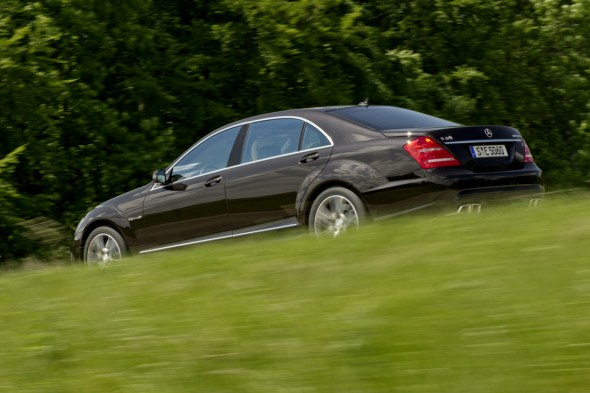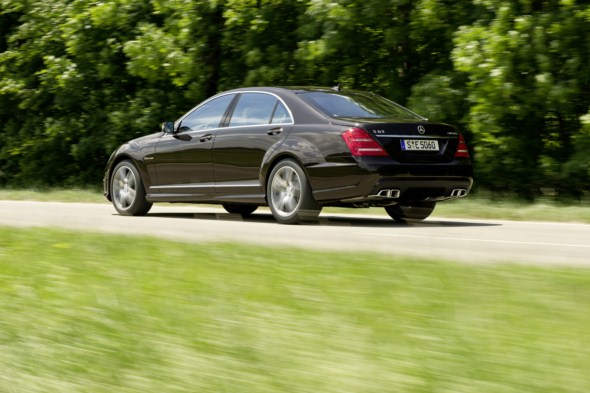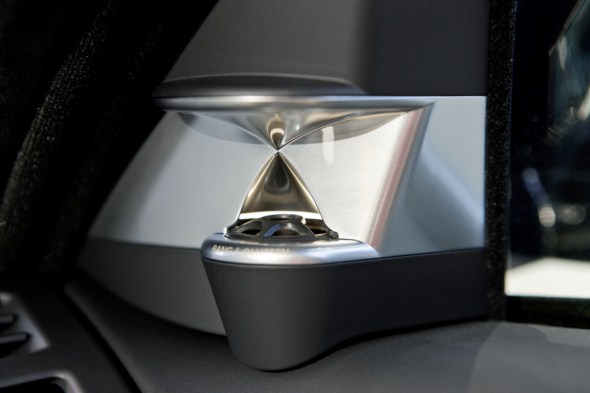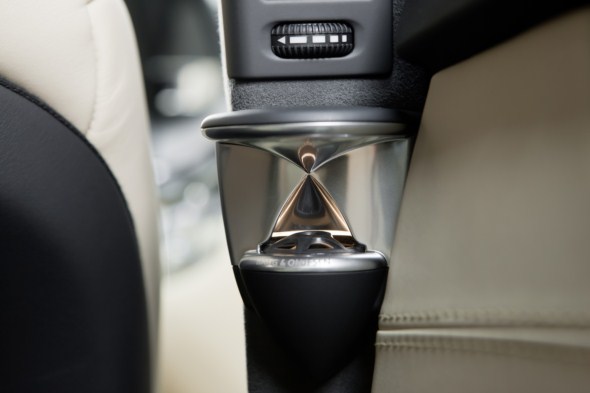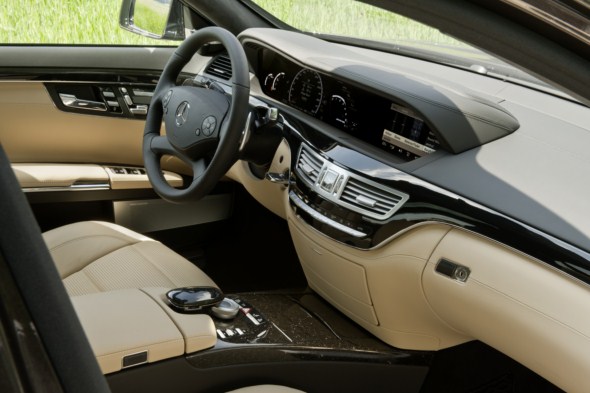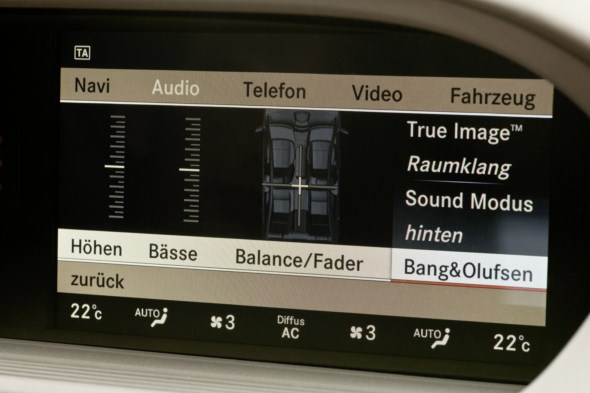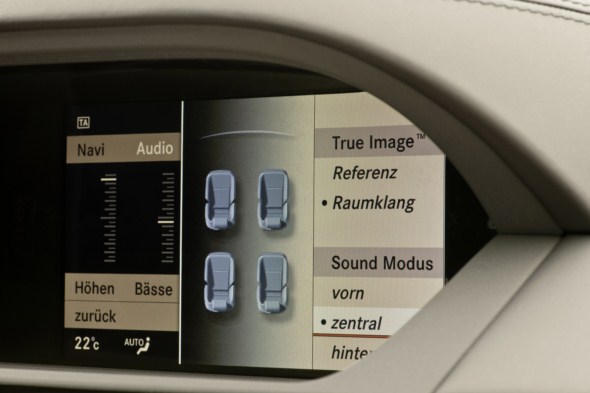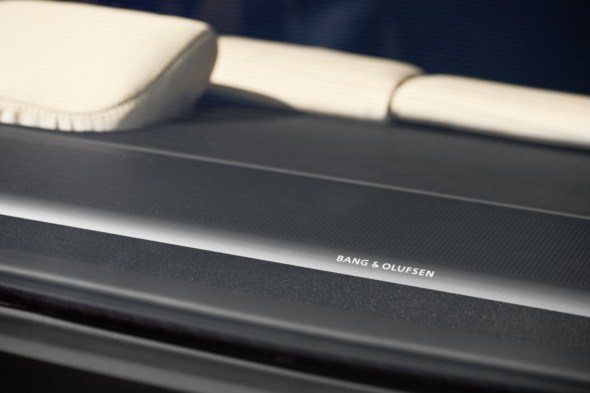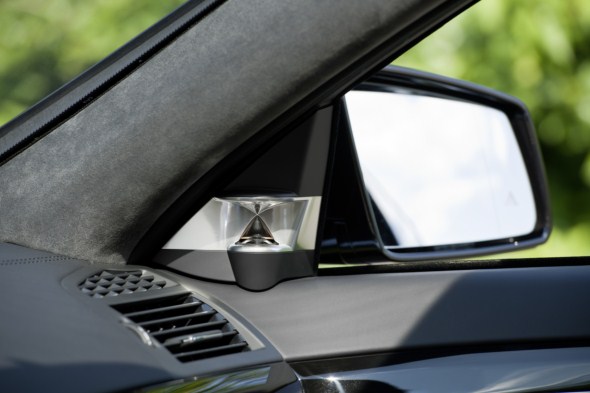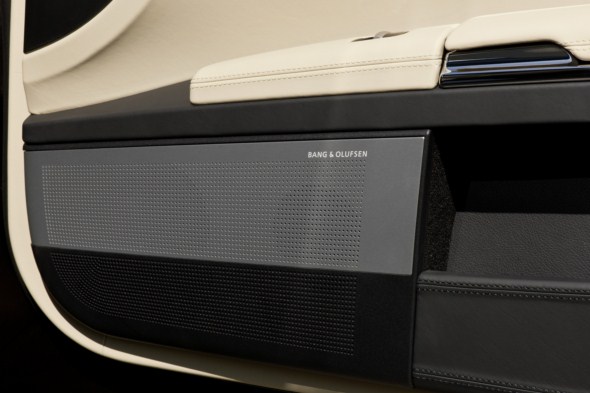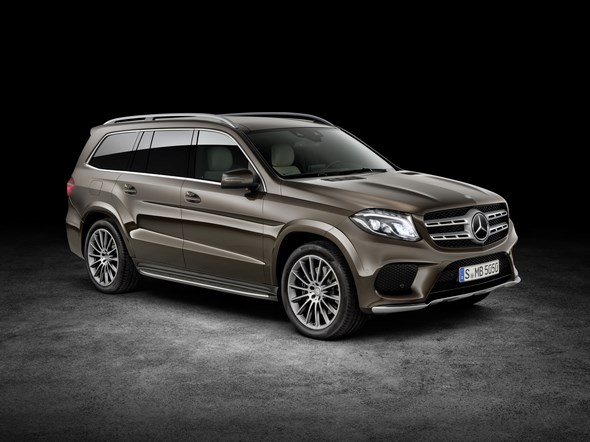Mercedes S63 New powertrain with the AMG 5.5-litre V8 biturbo engine

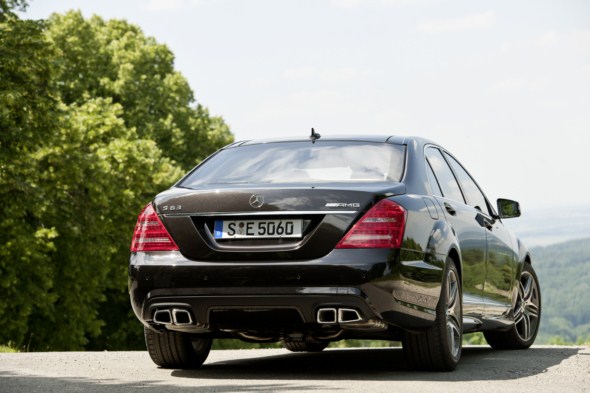
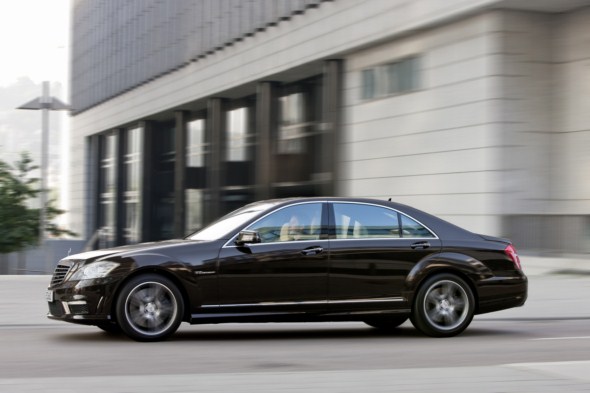
The new S 63 AMG marks the start of a new chapter in the “AMG Performance 2015” drive strategy: Mercedes-AMG is continuing this impressive story and is meeting its promise to continuously reduce both the fuel consumption and emissions of new models with the new engine/transmission combination – while reaching new heights with the central AMG brand value of “performance”.
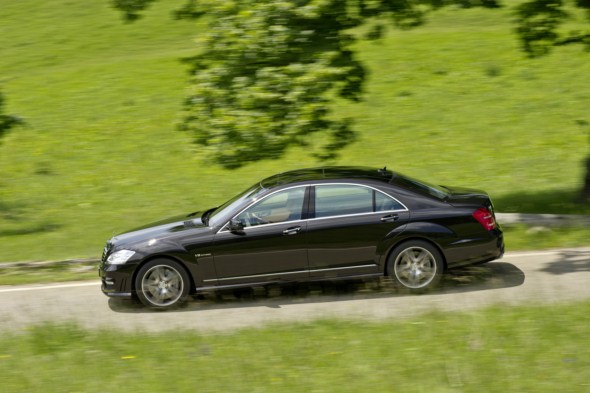
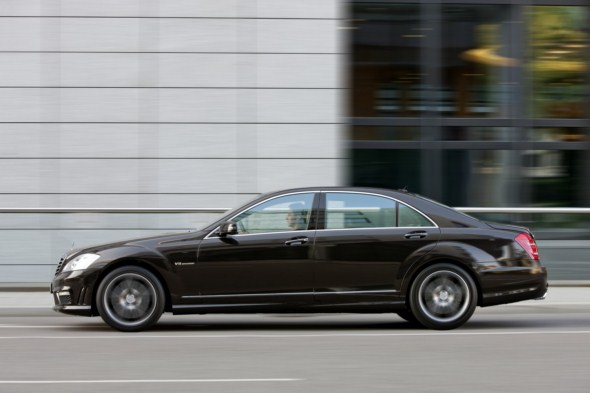




- AMG Performance package: increase in maximum power of 20 kW (27 hp) and maximum torque of 100 Nm, genuine carbon fibre AMG engine cover
- AMG double-spoke forged wheels, painted in black with a mirror finish and fitted with 255/35 R 20 front and 275/35 R 20 rear tyres
- AMG Performance steering wheel with Alcantara inserts in the grip areas
- AMG trim in black piano lacquer/carbon fibre
- S 63 AMG (short wheelbase): 128,800 euros (excl. VAT) / 143,752 euros (incl. 19% VAT)
- S 63 AMG (long wheelbase): 127,200 euros (excl. VAT) / 151,368 euros (incl. 19% VAT)
- The AMG Performance package costs 7900 euros (excl. VAT) / 9401 euros (incl. 19% VAT).
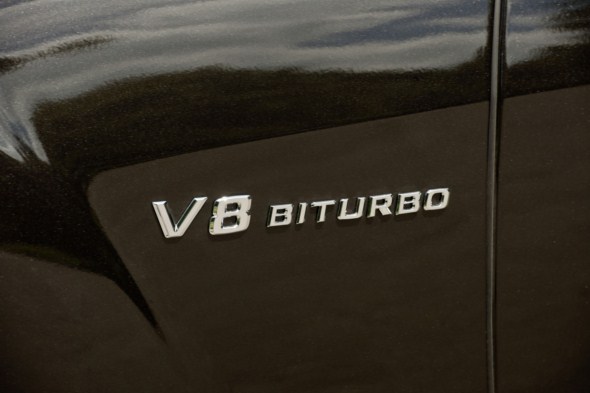
At a glance:
The highlights of the new AMG V8‑biturbo engine and the AMG SPEEDSHIFT MCT 7-speed sports transmission
- Direct petrol injection with piezo-electric injectors and spray-guided combustion
- Twin turbochargers with air/water intercooling
- Sophisticated engine electronics with Controlled Efficiency start/stop function and generator management
- Aluminium crankcase with ventilation holes to reduce friction
- Continuous camshaft adjustment on the intake and exhaust sides
- Demand-controlled engine oil pump
- AMG SPEEDSHIFT MCT 7-speed sports transmission with compact start-up clutch and three drive modes
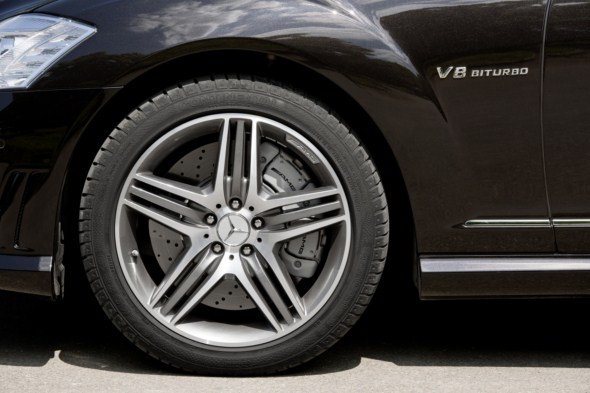
Engine technology: development goals and design
Perfect combination of performance and efficiency
Emotional peak performance and enormous torque, agile power delivery and a characteristic engine sound, comfort on long journeys and hallmark Mercedes reliability: expectations are high when Mercedes-AMG introduces a new high-performance engine – and its very first biturbo eight-cylinder is no exception. Two criteria are inexorably gaining in importance, namely efficiency and economy. Mercedes-AMG is confronting the challenges of the future, and demonstrating that dynamic performance can be perfectly combined with fuel economy.
The new AMG 5.5-litre biturbo engine combines performance with efficiency to a previously unknown extent. This is made possible by a unique combination of innovative high-tech systems such as direct petrol injection, twin turbochargers, air/water intercooling and the Controlled Efficiency start/stop function.
Mercedes-AMG is systematically following the trend towards increasing efficiency with its new V8 biturbo engine: with a displacement of 5461 cubic centimetres it is precisely 747 cc below the 6208 cc of the naturally aspirated AMG 6.3-litre V8. Nonetheless it considerably betters it in terms of output and torque. It develops a peak output of 400 kW (544 hp) and maximum torque of 800 Nm. In conjunction with the AMG Performance Package these figures increase to 420 kW (571 hp) and 900 Nm. The torque curve in particular shows that no other engine in this output class is able to match the figures delivered by the new AMG biturbo unit.
Despite an increase in output of 14 kW (19 hp) and 34 kW (46 hp) respectively, and in torque of 170 and 270 Nm compared to the naturally aspirated V8, which develops 386 kW (525 hp) and 630 Nm, AMG engineers have been able to reduce fuel consumption and CO2 emissions considerably. With an NEDC fuel consumption of only 10.5 litres per 100 kilometres, the new S 63 AMG betters its predecessor by 3.9 litres. This equates to a fuel saving of more than 25 percent, which engine specialists consider to be nothing less than a quantum leap. CO2 emissions have likewise been significantly reduced: at 244 grams per kilometre, the figure is almost 30 percent lower than for the previous model (344 g/km).
The achievement of these efficiency and environmental aims has no negative effects whatsoever on dynamic performance. On the contrary, as the new AMG 5.5-litre V8 biturbo fully lives up to AMG’s brand commitment to “performance”: the S 63 AMG accelerates from zero to 100 km/h in 4.5 seconds, and has a top speed of 250 km/h (electronically limited). With the AMG Performance package, the high-performance saloon reaches the 100 km/h mark in 4.4 seconds and reaches a top speed of 300 km/h (electronically limited).
Key data at a glance:
S 63 AMG S 63 AMG with AMG Performance package
Cylinder arrangement V8 V8
Cylinder angle
90o 90o
Valves per cylinder 4 4
Displacement
5461 cc 5461 cc
Bore x stroke
98.0 x 90.5 mm 98.0 x 90.5 mm
Cylinder spacing
106 mm 106 mm
Compression ratio
10.0:1 10.0:1
Output
400 kW (544 hp) at 5500 rpm 420 kW (571 hp) at 5500 rpm
Output per litre
73 kW (100 hp) 77 kW (104 hp)
S 63 AMG S 63 AMG with AMG Performance package
Max. torque
800 Nm at 2000 – 4500 rpm 900 Nm at 2250 – 3750 rpm
Torque per litre
146 Nm 165 Nm
Maximum engine speed
6500 rpm 6500 rpm
Mean pressure
18.5 bar 20.8 bar
Engine weight (dry)
204 kg 204 kg
Power/weight ratio
0.37 kg/hp 0.36 kg/hp
Fuel consumption
NEDC combined
10.5 l/100 km 10.5 l/100 km
CO2 emissions
244 g/km 244 g/km
Acceleration 0 – 100 km/h
4.5 s 4.4 s
Top speed
250 km/h* 300 km/h*
* electronically limited
Combination of twin turbocharging and direct petrol injection
Mercedes-AMG is presenting an attractive high-tech package with its combination of biturbo charging and direct petrol injection with spray-guided combustion. The innovative injection technology brings decisive advantages with respect to fuel consumption and exhaust emissions, thanks to higher thermodynamic efficiency. Particularly fast and precise piezo-electric injectors spray the fuel into the combustion chambers, ensuring a homogenous fuel/air mixture and highly effective combustion.
A electric low-pressure pump delivers the fuel from the tank to a high-pressure pump in the boot with a pressure of six bar. The fuel pressure in the high-pressure rail is controlled between 100 and 200 bar on a fully variable and demand-related basis.
Two turbochargers and efficient air/water intercooling
Two turbochargers located next to the cylinder banks supply the eight cylinders with fresh air. At their maximum speed of 185,000 rpm under full load, the two turbochargers force 1750 kg of air into the combustion chambers per hour. The maximum charge pressure is 1.0 bar, and 1.3 bar with the AMG Performance package. Thanks to their specific, compact construction – the turbine housings are welded to the exhaust manifold – there are significant space advantages and the catalytic converters also heat up more rapidly.
The new AMG V8 is the first turbocharged engine to dispense with the usual blow-off valve. This neat solution enabled the compressor housing to be made extremely compact. To ensure agile responsiveness with no time lag, all the air ducts in the intake tract are as short as possible. The wastegate valve, which reduces the pressure in the exhaust system during negative load changes, is vacuum-controlled via an electropneumatic converter. This allows dethrottling under partial loads, which in turn lowers the fuel consumption.
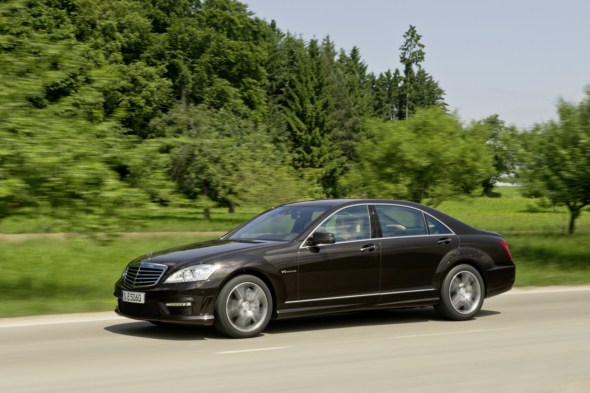
As was already the case in the AMG 6.0-litre V12 biturbo engine, the new eight-cylinder direct-injection unit uses particularly efficient air/water intercooling. The low-temperature cooler with its water circulation is space-savingly accommodated within the V of the cylinder banks. It effectively cools down the intake air compressed by the turbochargers before it enters the combustion chambers, and maintains a constantly low intake temperature under full load. A large radiator at the car’s front end ensures defined cooling of the water circulating in the low-temperature circuit. This guarantees a high output and torque yield in all ambient temperatures and operating conditions.
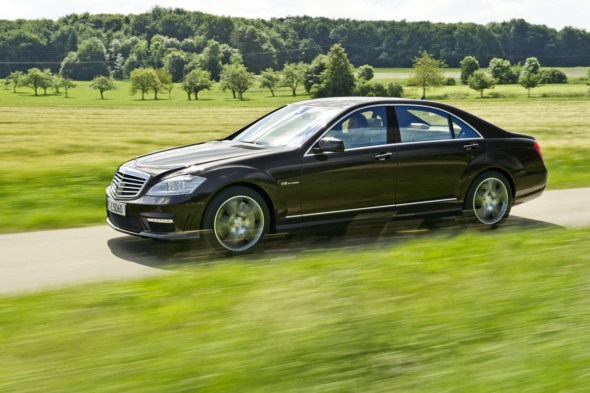
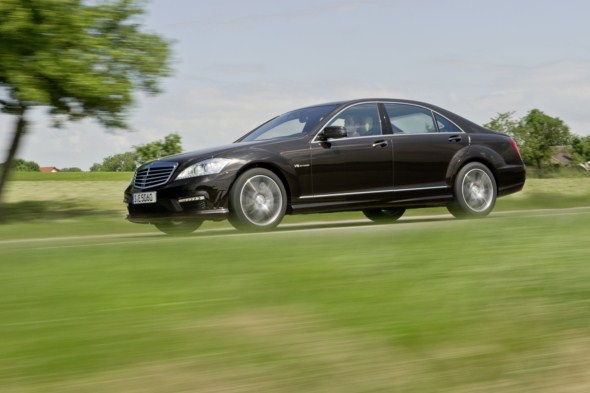
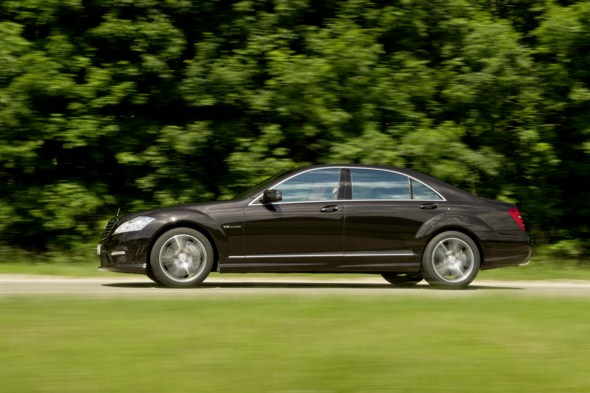
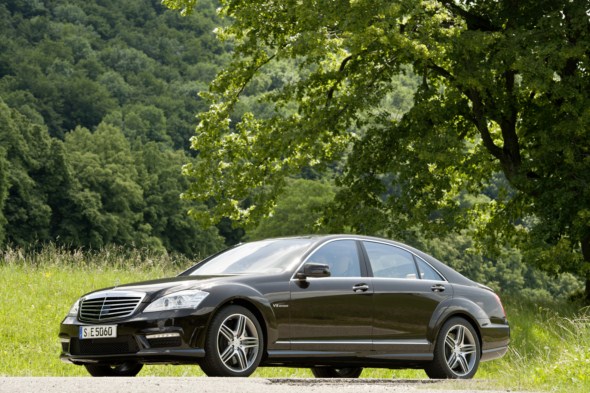
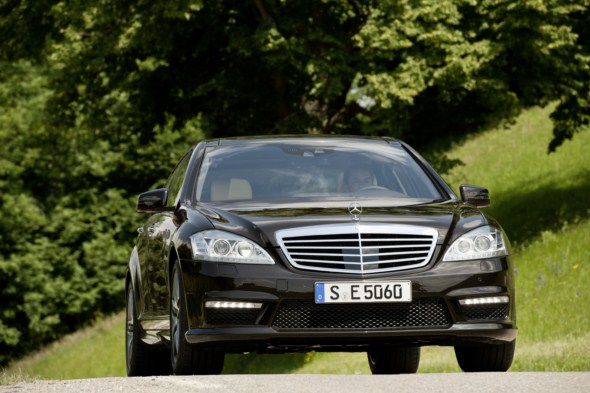
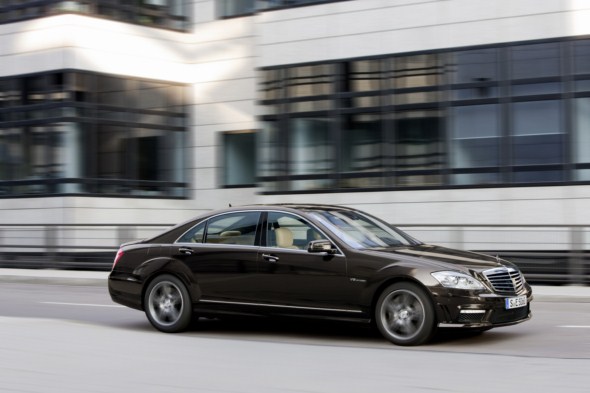
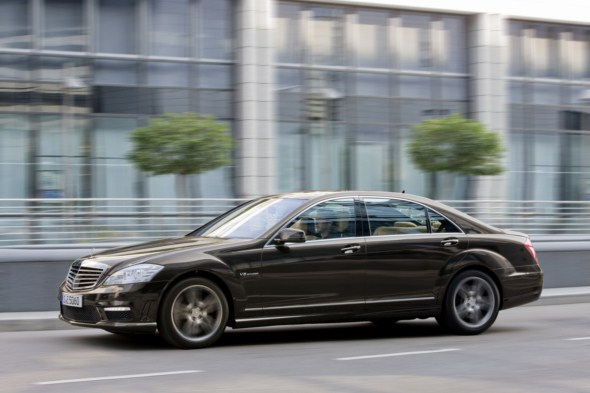
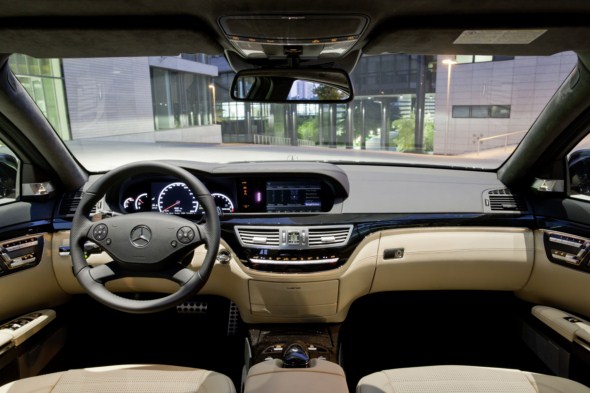
Extremely short charge air ducting makes for outstanding responsiveness. The stainless steel pressure pipes for the fresh and charge air are produced by the hydroforming process, have a wall thickness of only 0.8 millimetres and are designed for particularly low pressure loss.
Aluminium crankca se with Silitec cylinder liners The crankcase of the new AMG 5.5-litre V8 biturbo engine is of diecast aluminium. The low (dry) engine weight of just 204 kilograms is the result of uncompromising lightweight construction methods, and leads to the car’s very balanced weight distribution. The bearing cover for the main crankshaft bearings is of grey cast iron, and is bolted to the crankcase for high rigidity. Cast-in Silitec cylinder liners ensure that the eight pistons operate with low friction. Drilled pulsation holes in the crankcase lead to a higher output and fuel savings under partial load: above the bearing blocks there are longitudinally drilled holes which connect adjacent crankcase cavities. Normally the upward and downward movement of the pistons causes air to be forced into and extracted from the sump, which leads to increased internal friction losses and therefore a reduction in output. The pulsation holes prevent this by ensuring effective pressure compensation between the cavities.
The forged crankshaft of high-grade 38MnS6BY steel alloy rotates in five main bearings, has eight counterweights and has been optimised with respect to torsional rigidity, inertia, low rotating masses and a long operating life. A two-mass viscous damper mounted at the front reliably eliminates vibrations. Each connecting rod journal on the crankshaft carries two forged, cracked connecting rods. In the interests of low mechanical friction and high wear resistance, the lightweight pistons have a metallic contact surface. Pressure-controlled oil-spray nozzles in the crankcase ensure that the highly stressed piston crowns are efficiently cooled.
Four-valve technology with variable camshaft adjustment Perfect charging of the combustion chambers is ensured by large intake and exhaust valves, of which there are four per cylinder. The exhaust valves, which are subject to high thermal loads, are hollow and sodium-cooled. Four overhead camshafts operate the 32 valves via low-maintenance, low-friction cam followers. The infinitely variable camshaft adjustment within a range of 40 degrees on the intake and exhaust sides depends on the engine load and engine speed, leading to outstanding output and torque values. This also results in consistent idling at a low speed. Depending on the engine speed, valve overlap can be varied for the best possible fuel/air supply to the combustion chambers and efficient removal
of the exhaust gases. The variable camshaft adjustment is carried out electromagnetically via four pivoting actuators, and is controlled by the engine control unit. The camshafts are driven by three high-performance silent chains, which have considerable advantages in noise comfort compared to cylinder roller chains.
Efficient oil supply and water cooling
Efficient oil delivery under all load and operating conditions is ensured by an oil pump with an electrically controlled compression stage. The oil pressure can be varied between two and four bar, which has advantages in terms of friction and fuel consumption. An extraction stage integrated into the oil pump for the two turbochargers prevents oil from being entrained into the charge air and exhaust gases, thereby helping to reduce emissions even further. Both the sump and the extraction point have been optimised for maximum lateral acceleration and efficient lubrication. The oil capacity is 10.5 litres.
The combined water/oil cooling system is a particularly clever solution: initially the engine oil only flows through the oil/water heat exchanger. If the cooling performance of the very compact cooler is insufficient, the flow is directed through the external engine oil/air cooler by an oil thermostat. The advantage of this system is that the engine oil warms up more rapidly, as the engine coolant warms up faster and the oil is later cooled by the coolant. A selectable water thermostat ensures rapid warming of the coolant when starting the engine and driving off.
The engine coolant is cooled on the particularly effective crossflow principle.
There is a transverse flow of coolant through both the crankcase and the cylinder heads. Additional cooling slots in the cylinder head ensure more efficient cooling of the combustion chambers, which has advantages during combustion: it enables earlier ignition timings to be chosen without incurring the risk of knocking.
Highly efficient engine electronics for every function
All the engine functions are executed and controlled by a particularly efficient Bosch MED 17.7.3. control unit. This state-of-the-art engine computer not only controls the direct petrol injection, charge pressure, camshaft adjustment and variable oil supply, but also communicates with all the other onboard control units. The microprocessor has more than 30,000 different parameters and functions stored in its memory, and is able to perform up to 260 million individual operations per second. To reduce the load on the engine control unit, the eight individual ignition coils have an integral electronic module known as an ignition amplifier at each cylinder. These ensure a strong ignition spark at all engine speeds and under all load conditions. Eight high-voltage powerstages are responsible for highly precise fuel distribution to the piezo-electric injectors.
Effective emissions technology with new catalytic converter boxes Low exhaust emissions, compliance with country-specific standards and a characteristic AMG engine sound – the requirements for the exhaust system of the new AMG 5.5-litre V8 biturbo engine were manifold and complex. The S 63 AMG complies with all the current EU-5 emission standards, as well as meeting all the requirements of the US market (LEV-II standard, On-Board Diagnosis II and lambda sensor diagnosis).
The turbochargers are welded to the exhaust manifolds, while air gap-insulated manifolds with a wall thickness of only 1.0 millimetres ensure a rapid catalytic converter response. For efficiency and to save space, this concept has a tandem catalytic converter housing on each side of the vehicle: adjacent to the firewall, two thin-walled ceramic substrates are grouped into each housing. This solution makes the previous, additional underbody catalytic converters unnecessary. The two ceramic substrates differ to ensure rapid and efficient emissions control: the front one is coated with palladium, while the rear one has a bimetal coating of palladium and rhodium. One lambda sensor per row of cylinders is located in front of each catalytic converter housing, and there is a lambda diagnostic sensor between each of the two thin-walled substrates.
The lambda sensors are necessary for demand-related lambda control. In all operating conditions, the constituents of the intake mixture can be precisely controlled to avoid damaging the catalytic converters. This also benefits the fuel consumption under full load, as the mixture can be leaner than in engines without this control system. Twin-pipe AMG sports exhaust system for a characteristic sound signature The twin-pipe AMG sports exhaust system has a pipe cross-section of 70 millimetres from the manifolds to the rear silencers. When designing the sound, the aim was to create a perfect synthesis of perceived dynamism and the comfort on long journeys that is the hallmark of a Mercedes. The goal of the developers was to achieve an emotional experience when accelerating and double-declutching, but unobtrusiveness at constant speeds. Unpleasant frequencies or droning noises were effectively eliminated during a series of painstaking tests. The sports exhaust system emits a sonorous eight-cylinder sound that is typical of AMG, while the striking chrome twin tailpipes feature a new design.
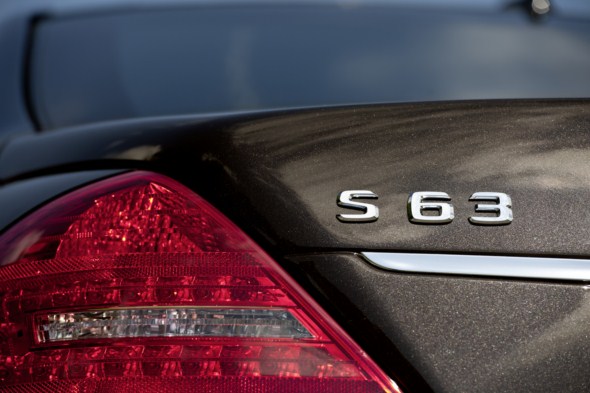
Active and passive safety
Unique combination of trend-setting driver assistance systems Throughout the world the Mercedes-Benz S-Class is synonymous with the ultimate in active and passive safety systems. A significant part of such systems is also made up of the unique combination of trend-setting camera and radar-based driver assistance systems. The latest innovations are called Active Lane Keeping Assist and Active Blind Spot Assist, both of which are available as optional extras.
The combination of state-of-the-art assistance and protection systems turn the AMG S-Class into an “intelligent” partner which is able to “see”, “feel”, to respond “instinctively” to detected dangers and to act “on its own initiative” in order to avoid accidents or to reduce the severity of accidents. The vehicle makes use of cameras radar sensors which look far ahead, observe the conditions around the vehicle, and are able to interpret typical critical situations.
When the S 63 AMG unintentionally drives over a solid line to the right or left of a lane or on the outside of a bend, the new Active Lane Keeping Assist intervenes and prevents the vehicle from unintentionally leaving the lane. In such cases it applies the brakes to the wheels on the opposite side of the vehicle, using the sensor system of the Electronic Stability Program ESP®.
Similarly, when the new Active Blind Spot Assist system detects that changing lanes would be dangerous, it the driver by displaying a red warning in the glass of the relevant exterior mirror. If the driver ignores the warning signal and a vehicle in an adjacent lane comes too close, the ESP® takes corrective action by applying the brakes to the wheels on the opposite side of the vehicle.
Night View Assist PLUS and Speed Limit Assist The Night View Assist Plus with infrared camera (optional extra) is equipped with a special pedestrian detection function: as soon as the system detects pedestrians on the road ahead, they are highlighted on the display to make them more readily noticeable.
The images supplied by the windscreen camera are also used by the Speed Limit Assist, which is available as an optional extra. It recognises speed limit signs in passing and shows the relevant speed limit in the central display.
Drowsiness detection on the basis of more than 70 parameters
Thanks to an innovative technology the S-Class has a very sensitive antenna for the attention level of its driver, and can warn him in time when he becomes drowsy. The ATTENTION ASSIST drowsiness detection system continuously monitors more than 70 different parameters. Once the evaluation electronics recognise the
steering behaviour pattern that typically indicates the onset of drowsiness on the basis of information from the highly sensitive steering angle sensor, a warning signal is sounded and “ATTENTION ASSIST. Break!” appears in the instrument cluster. ATTENTION ASSIST is fitted as standard. “Electronic crumple zone” for maximum occupant protection In addition, Mercedes-Benz has enhanced the wide and intermediate range
radars for the optional extras Brake Assist PLUS (BAS PLUS) and DISTRONIC PLUS proximity control. Mercedes-Benz also offers another radar based system for the S-Class in the form of the PRE-SAFE® brake. If the driver is distracted and fails to recognise the immediate danger of a rear-end collision, or the warning signal of an assistance system, this system can intervene and brake the vehicle independently. The S-‑Class makes use of the latest development stage of this safety system: if the driver fails to react even after automatic, partial braking action, the PRE-SAFE® Brake activates the maximum braking pressure around 0.6 seconds before what is now recognised as an unavoidable accident – an emergency braking action that can significantly mitigate the severity of the impact. The PRE-SAFE® Brake therefore acts as something like an “electronic crumple zone”.
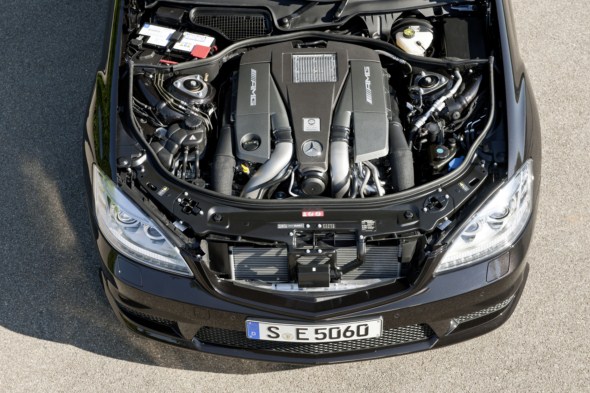
Individualisation
AMG Performance Studio and designo reflect the owner’s personal style
Optional extras from the AMG Performance Studio and from designo – two bywords for exclusive style, superb individuality and uncompromising sportiness. Customers with their very own style can choose from a wide range of exclusive equipment and appointments for the S-Class AMG models.
The AMG Performance Studio, which opened its doors in Affalterbach in 2006, aims to meet even the most discerning customer requirements and supplies AMG trim elements in black piano lacquer/carbon fibre which are available ex factory for S-Class AMG models. While the dashboard and the door trim are adorned with dazzling, black wood trim, both the front centre console and the folding rear armrest are trimmed in genuine carbon fibre. The high-grade material mix lends the interior a definite dynamic touch as an option – and subtly alludes to AMG’s eminently successful motorsport heritage. The AMG performance steering with Alcantara inserts in the grip area not only feels good but also makes a striking visual impact.
AMG forged wheels painted in black with a mirror finish are also available for the S 63 AMG. The eye-catching twin-spoke wheels are fitted with 255/35 R 20 (front) and 275/35 R 20 (rear) tyres.
Exclusive designo line-up with designo Selection
The entire designo range is available to provide further individualisation options. Ten different designo paint finishes can be combined with ten designo aniline leather appointments options – with the result that there are practically unlimited possibilities for customers to turn their personal preferences into reality.
Particular highlights come courtesy of the three matt paint finishes designo magno platinum, designo magno allanite grey, designo magno cashmere white, the high-sheen designo mystic brown paintwork, not to mention the designo aniline leather in deep white. The designo aniline leather colours deep white, deep black and light brown provide customers with even more individualisation options. When it comes to designo the customer can choose from six different exclusive trim options: natural maple grain and matt natural oak grain as well as two high-sheen piano lacquer trim options in black or champagne white. The unique designo stone trim elements made from genuine granite are available in two versions for the S-Class: Labrador blue pearl and Star Galaxy. To highlight the exclusivity of the designo trim elements, customers can adorn the rear air conditioning unit cover with handmade designo lettering in 925 sterling silver.
Mercedes-Benz is offering a high-end equipment package for the S 63 AMG with a long wheelbase and the S 65 AMG – all in the shape of the designo Selection. Customers are able to configure their S-Class according to their personal preferences and taste from all the designo paint finishes, designo leather colours and designo wood trim options. Other components of the package include a black roof liner in nappa leather with special fluting, a matching designo wood/leather steering wheel and designo lettering in solid 18-carat gold – hand-finished exclusively for the designo Selection – on the rear air conditioning unit cover.
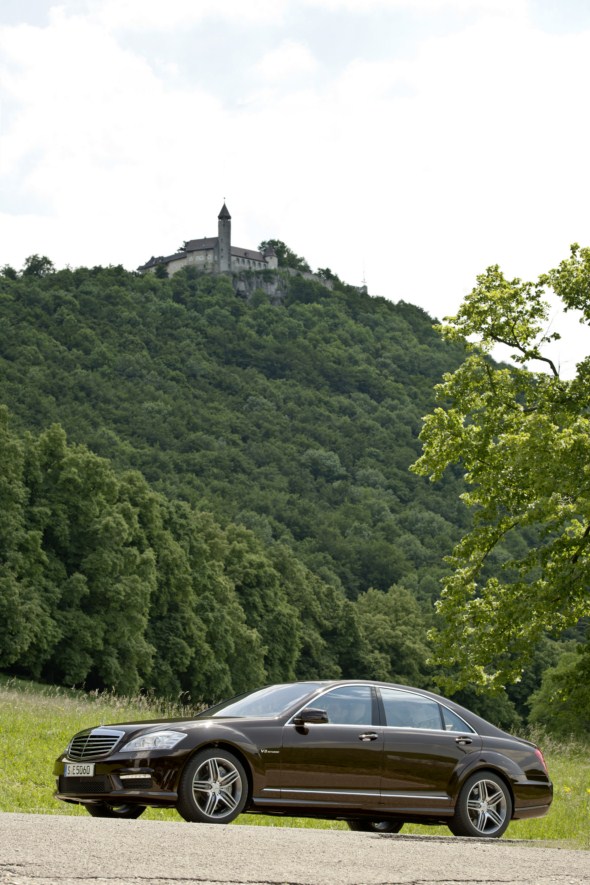
History
A comparison between generations of a special kind
Wide, spectacular and clad in an authentic racing car outfit – two very special S-Class saloon models from the AMG stable. One is the racing touring car of 1971, the 300 SEL 6.8 AMG, and the other is the S 63 AMG “Thirty-Five”. With identical sponsoring and the memorable start number “35”, the high-performance model is a reminder of a historic success: on 25 July 1971, the bright red four-door saloon crossed the finishing line in second place at the 24-hour race in Spa-Francorchamps. This triumph in the car’s very first race made AMG world-famous overnight.
The highly experienced Hans Heyer and Clemens Schickentanz took turns behind the wheel of the AMG touring car. AMG was anything but the favourite to win this classic Belgian long-distance race: it faced the mighty opposition of the Ford Capri RS, BMW 2800 CS, Chevrolet Camaro , Opel Commodore and Alfa Romeo GTA.Nobody expected that the large luxury saloon from Affalterbach in provincial Swabia would be able to keep pace with the well-established teams.
5th place in the starting lineup for AMG The red four-door saloon already showed its potential in training, when Clemens Schickentanz surprised everyone with the fifth-fastest training time. Indeed nobody at AMG had expected fifth place in a starting lineup of 60 cars. 80,000 spectators wondered about the fast, red saloon with its long wheelbase – the only Mercedes taking part in the race. Pole position was occupied by the favourite,
the Chevrolet Camaro driven by Ivo Grauls and Peter Hoffmann, followed by the Alpina-BMW 2800 CS of Niki Lauda/Gérard Larousse, then the first works Ford Capri with Dieter Glemser and Alex Soler-Roig, and the Schnitzer-BMW 2800 CS piloted by Rauno Aaltonen and Helmut Kelleners. All in all, 60 racing touring cars were seeking to beat the stopwatch on the then 14.1-kilometre course in the Ardennes, driven by well-known names such as Hans-Joachim-Stuck, Jochen Mass, Toine Hezemans, Willy Kauhsen, Achim Warmbold and Rainer Braun.
On the first lap, driver Hans Heyer in the 300 SEL 6.8 AMG was able to manoeuvre into 3rd place right behind the Ford Capri (Glemser/Soler-Roig) and the Chevrolet Camaro (Grauls/Hoffmann). After a turbulent race with a rainstorm at midnight and numerous breakdowns, the “35” finally crossed the finishing line in second place behind the works Capri driven by Glemser/Soler-Roig. The AMG saloon had absolved exactly 308 laps in the 24 hours. Technical problems: none at all. A sensational result.
Top speed of 265 km/h and exotic wood trim in the cockpit
Hans Heyer looks back fondly on this race: “We knew we could win, but the others did not know that yet!” The AMG saloon was unbeatable on the straight, however the braking system substantially adopted from the standard model had problems coping with the weight of the car (1635 kilograms). “But on the old Spa course the discs had plenty of time to cool down, and nobody was able to catch us on the long straights,” the now 67 year-old reminisces. With a top speed of 265 km/h, the 300 SEL 6.8 AMG was tailor-made for the fast Belgian track. The interior had a luxurious atmosphere with its standard appointments such as power steering, air suspension, carpets, panelled doors and a dashboard with exotic wood trim. The spectators along the trackside enthusiastically cheered the large saloon with its unmistakable V8 sound. “The outsider quickly became the public’s favourite,” says Hans Heyer.
The AMG racing saloon was technically based on the Mercedes-Benz 300 SEL 6.3. With an engine output of 184 kW (250 hp) at 4000 rpm and a top speed of 220 km/h, this luxury saloon was Germany’s fastest regular production car at the time. It was not only an enlarged displacement from 6330 to 6835 cc that increased the output to 315 kW (428 hp) at 5500 rpm, and torque from 500 to 608 Nm. AMG co-founder Erhard Melcher “tweaked” the eight-cylinder power unit using classic methods: high-precision camshafts and modified rocker arms, lighter connecting rods, new Mahle pistons, larger intake valves, modified combustion chambers, polished intake and exhaust ducts, a new intake tract with two throttle flaps and a racing exhaust system ensured a better gas throughflow and made higher engine speeds possible. Endurance was improved by installing an additional oil cooler and finely balancing the crankshaft.
The wings were flared to make room for the lightweight size 10 x 15 and 12 x 15-inch magnesium wheels adopted from a C 111 test car. Aluminium doors helped to reduce the car’s weight from the original 1830 to 1635 kilograms. Larger front wishbones, a more robust rear axle with a heavy-duty differential and smaller, stiffer suspension air bellows made the saloon fit for the racetrack.
Sensational success reported on German TV news
The unexpected success in the 24-hour race at Spa-Francorchamps made AMG, which was founded in 1967, well-known overnight – and marked the start of an impressive success story. Even the German TV news “Tagesschau” reported on this sensational result. “It really was a sensation at the time,” AMG founder Hans Werner Aufrecht remembers. The courage shown by Aufrecht and his partner Melcher in entering such a car in the classic 24-hour race had been well rewarded. Afterwards the 300 SEL 6.8 AMG took part in the 2×6-hour race at Paul Ricard on 11 and 12 September 1971, accompanied by a privately entered 300 SEL 6.3 with an AMG engine. In March 1972, now repainted in yellow, the 300 SEL 6.8 AMG took part in the trials for the Le Mans 24-hour race, but did not take to the starting line for the June race. The car was however entered in the 24-hour race at the Nürburgring in June 1972, and in the Nuremberg 200-mile race at the Norisring on 6 August 1972, where Hans Heyer took first place in the “Standard and special touring cars above 2000 cc” category with the four-door saloon, which had meanwhile been painted red again. The success story of the 300 SEL 6.8 AMG came to an end there: a rule-change by the Fédération Internationale de l’Automobile (FIA) put the brakes on this muscular racer, as only cars with an engine displacement of up to five litres were permitted to enter European Touring Car Championship races in future. AMG sold its racing saloon to the French
Matra group, where it was converted for high-speed tests on aircraft tyres. Its subsequent fate is unknown. In spring 2006 Mercedes-AMG built a replica of the 300 SEL 6.8 AMG according to the original drawings, so as to keep this unique success story alive. Spectacular S 63 AMG “Thirty-Five” in the style of the racing touring car Like its historic predecessor, the new S 63 AMG “Thirty-Five” does not fail to attract attention. Eye-catching details include the imposing tyre sizes of 275/35 R 20 and 325/30 R 20 at the front/rear, and the 4.5 cm flare on each wing. The start number 35 and practically all the sponsoring stickers follow the original. Instead of fire-red non-metallic paintwork, the body of the showcar isfinished in “AMG Le Mans red metallic”, a colour available exclusively for the new SLS AMG. The functional interior is enhanced with black/carbon-fibre piano lacquer trim. A rollover cage, two AMG sports bucket seats with four-point seat belts and an AMG sports steering wheel lined in leather/Alcantara underline the racing touring car look.
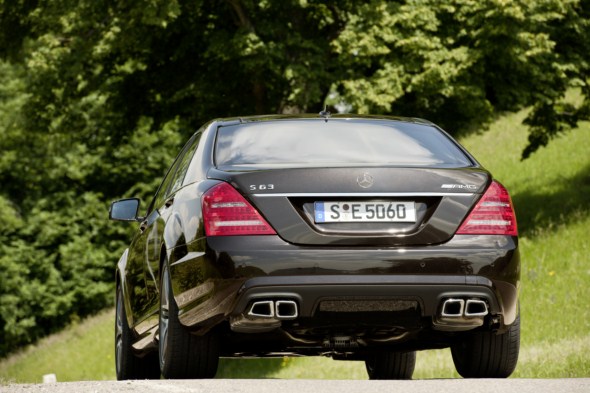
S 65 AMG
The exclusive crowning glory for enthusiasts
Luxury, power and sound, all in perfect harmony – this is what the Mercedes-Benz S 65 AMG is all about. The unique twelve-cylinder Saloon from AMG has a small but loyal community of fans. Since its launch in 2003, the S 65 AMG has been seen as the epitome of exclusive and effortless superiority. The same can also be said of the latest model year variant, which features a number of subtle visual enhancements, an increase in power output to 463 kW (630 hp), as well as a reduction in fuel consumption and emissions.
Among engine specialists and car enthusiasts, a twelve-cylinder engine has always represented the crowning glory of the engine builders’ craft. A very special example of this luxurious engine series is the AMG 6.0-litre V12 biturbo engine, as used in the S 65 AMG. Just one glimpse of the engine specifications is enough to reveal why: with a displacement of 5980 cubic centimetres, the AMG V12 generates 463 kW (630 hp) at engine speed of 4800 rpm. The maximum torque of 1000 Nm has been electronically limited – from a possible 1200 Nm – to make allowances for the powertrain, and remains constant between 2300 and 4300 rpm.
The performance of the vehicle is evidence of the exceptional power of the AMG twelve-cylinder engine: the S 65 AMG accelerates from 0 to 100 km/h in just 4.4 seconds, and is capable if hitting a top speed of 250 km/h (electronically limited).
Key data at a glance:
S 65 AMG
Displacement 5980 cc
Bore x stroke 82.6 x 93.0 mm
Compression ratio 9.0 : 1
Output 463 kW (630 hp) at 4800 rpm
Max. torque 1000 Nm at 2300 – 4300 rpm*
Fuel consumption
NEDC combined 14.3 l/100 km
CO2 emissions 334 g/km
Acceleration 0 – 100 km/h 4.4 s
Top speed 250 km/h*
* electronically limited
AMG has made a number of additional detailed enhancements to the engine, which has been in production for the past seven years. The engine experts at AMG achieved the increase in output from the previous 450 kW (612 hp) to 463 kW (630 hp) thanks to new exhaust gas turbochargers. The inlet diameter of the compressor housing and also the exhaust gas ducts have been enlarged, and the resulting increase in air throughput, together with the new engine electronics, has resulted in an increase of 13 kW (28 hp). The maximum charge-air pressure is 1.5 bars.
Despite the increase in output, it has still be possible to reduce fuel consumption and exhaust emissions: the NEDC combined fuel consumption of the S 65 AMG is now 14.3 litres per 100 kilometres, which equates to a reduction of 0.2 l/100 km. The CO2 emissions of 334 grams per kilometre are 3.5 percent lower than those of the previous model (346 g/km).
The reduction in consumption is down to new engine electronics as well as generator management: the kinetic energy generated during each drive phase of the engine and also when braking is used to charge the battery, and not just left to generate heat as would otherwise be the case. In all other operating areas, management of both the on-board electrical system and generator enables the generator to be maintained at a low voltage level.
New piston rings, a modified oil pump and use of a superior coating on the catalytic converters also contribute towards reducing raw exhaust emissions as part of the package of measures. Unique driving experience, exceptional in-gear acceleration The unrivalled effortless superiority of the AMG twelve cylinder engine can be enjoyed by drivers of the S 65 AMG in all driving situations: the tremendous acceleration characteristics are another one of its strengths, along with relaxed cruising at low engine speeds. Manual drive mode “M” in particular enables the high level of available torque and the exceptional in-gear acceleration to be enjoyed to the full. The exciting engine sound emitted by the two chrome twin tailpipes of the AMG sports exhaust system changes according to the driving style and situation: the repertoire ranges from a smooth, refined tone, through to the sonorous AMG-typical twelve-cylinder sound, all of which adds to the intensity of what is a high-performance driving experience.
Know-how from the world of motorsport also with the AMG biturbo V12 engine Characteristic features of the AMG 6.0-litre V12 biturbo engine include the vast know-how amassed by AMG from the world of motor sport and applied to the engine’s construction, and also the sophisticated air/water intercooler. It guarantees high power and torque output under all operating conditions, regardless of the outside temperature. Traditionally all engines are built by hand at Mercedes-AMG in Affalterbach – just as with the V12 engine. In line with the exceptional 1000 Nm torque, the S 65 AMG comes with a systematically reinforced powertrain. Power transfer is handled by the AMG SPEEDSHIFT five-speed automatic transmission, which has three different drive modes.
As is the case with the new S 63 AMG, the twelve-cylinder top-of-the-range model comes with the AMG sports suspension based on Active Body Control (ABC) with Torque Vectoring Brake, crosswind stabilisation and loading adjustment system. The characteristics of the AMG sports suspension can be changed by pressing the Sports button – for the driver, this translates into a noticeable reduction in the roll angle when cornering at speed, and also stiffer spring/damper tuning. The Direct-Steer system with speed-sensitive power steering, fitted as standard, guarantees high levels of maneuverability and smooth control in all driving situations.
Reliable deceleration performance comes courtesy of the AMG high-performance braking system based on the ADAPTIVE BRAKE system. Internally ventilated, perforated composite brake discs all round, with a diameter of 390 and 365 millimetres respectively, are combined with double floating brake callipers (front) and sliding frame-type callipers (rear) for maximum deceleration. Subtle but effective distinguishing features in the case of the V12 model The S 65 AMG comes with AMG twin-spoke forged wheels, painted in titanium grey with a mirror finish, measuring 8.5 and 9.5 inches wide. 255/35 R 20 tyres are fitted at the front, while 275/35 R 20 tyres feature at the rear. When it comes to appearance, the V12 model differs from the S 63 AMG in terms of the exclusive radiator grille with twin chromed louvres, the LED Light package including Intelligent Light System, and also the “V12 Biturbo” lettering on the front mudguards. In the interior, the AMG instrument panel features the “AMG V12 BITURBO” start screen as well as exquisite Exclusive PASSION leather upholstery: the entire instrument panel and door linings, and also the seatback panels are finished in leather, as are the magazine pockets and the parcel shelf. Alcantara is also used on the roof liner and on the A, B and C-pillars. Another new touch is the contrasting colour stitching.
The 12-way electrically adjustable AMG sports seats come with the Memory package, distinctive seat fluting and leather upholstery in the AMG V12 diamond pattern design, which also extends over the rear seats and all four door centre panels. Also fitted as standard is the Seat Comfort package, which includes front active multicontour seats with massage and dynamic handling function and NECK-PRO luxury head restraints and rear multicontour seats with massage function. All seats feature active ventilation and heating as well as the PRE-SAFE® positioning function.
Also fitted as standard is the Bang & Olufsen BeoSound AMG high-end sound system, including SPLITVIEW and Front Entertainment package. Newly developed especially for the S-Class by AMG together with renowned Danish hi-fi specialists Bang & Olufsen, the system promises a unique listening experience. With a total output of 1200 watts, 15 loudspeakers, acoustic lens tweeters in the A and B-pillars as well as a digital sound processor (DSP), it transforms the V12 saloon into a full-blown concert hall with perfect acoustics.
The extensive standard specification also includes (selection):
- Ambient lighting, adjustable in three colours
- Analogue clock featuring “IWC Ingenieur” design
- AMG door entry sills
- AMG floor mats
- AMG sports steering wheel
- AMG sports pedal cluster
- ATTENTION ASSIST
- KEYLESS-GO packag
- ISOFIX and automatic child seat recognition
- Convenience telephony
- LED Light package incl. Intelligent Light System
- Media interface
- Navigation package
- Electrically operated blind for rear window and rear doors
- Tilting/sliding glass sunroof, electric, with PRE-SAFE® closure function
- Door power closing
As with the S 63 AMG, Active Lane Keeping Assist and Active Blind Spot Assist (optional extras) are now also available for the S 65 AMG.
The S 65 AMG is available in a long-wheelbase version only and costs 192,500 euros (excl. VAT) / 229,075 euros (incl. 19% VAT).
